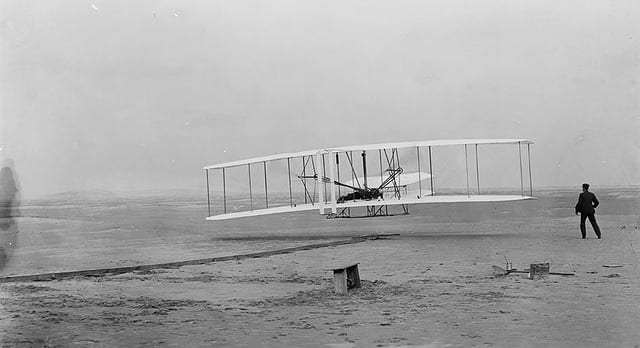LIFT FORCE
Similar to drag, the lift force is also produced by the relative motion between a solid object and a fluid. While the drag force acts in parallel to the direction of the fluid’s flow, the lift force acts in perpendicular to it. For instance, in the context of the airplane shown in Figure 6.26, the high-speed flow of air around the wings generates a vertical lift force FL that balances the plane’s weight. Four forces are shown acting on the aircraft in flight:
· the plane’s weight w,
· the thrust Ft produced by its jet engines,
· the lift Fl produced by the wings,
· and the drag Fd that opposes the motion of the plane through the air.

In steady level flight, those forces balance to keep the plane in equilibrium: the engines’ output overcomes wind resistance, and the wings’ lift supports the weight of the aircraft. Lift force is important not only for aircraft wings and other flight control surfaces, but also for the design of propeller, compressor, and turbine blades; ship hydrofoils; and the body contours of commercial and racing automobiles.
Lift Force in Aerodynamics
The area of mechanical engineering that encompasses the interaction between structures and the air flowing around them is called aerodynamics.When engineers are performing aerodynamic analysis of drag and lift forces, invariably they make approximating assumptions with respect to geometry and the behavior of the fluid. For instance, neglecting a fluid’s viscosity or compressibility can simplify an engineering analysis problem enough for an engineer to develop a preliminary design or interpret the results of measurements. On the other hand, engineers are mindful of the fact that such assumptions, while meaningful in some applications, could be inappropriate in others. As in our usage of Equations in drag force analysis, mechanical engineers are aware of the assumptions and restrictions involved when certain equations are applied. For example, in this article we assume that air is a continuous fluid, not a collection of discrete molecules that collide with one another. This assumption is effective for most applications involving the flow of air around automobiles and aircraft at low speeds and altitudes. However, for aircraft or space vehicles in the upper atmosphere, that assumption might not be appropriate, and engineers and scientists might instead examine fluid forces from the standpoint of the kinetic theory of gases.
Use of Wind Tunnels in measuring Lift Force
Mechanical engineers often use wind tunnels, such as those shown in Figure 6.27,to conduct experiments to understand and measure the forces generated when air flows around a solid object. Wind tunnels enable engineers to optimize the performance of aircraft, spacecraft, missiles, and rockets at different speeds and flight conditions. In such a test, a scale model of the object is built and attached to a special fixture for measuring the drag and lift forces developed by the airstream .

Shock Wave
Wind tunnels can also be used to perform experiments related to high-altitude and supersonic flight.Figure 6.28 depicts the shock waves that propagate off the scale model of an upper-atmosphere research aircraft. Shock waves occur when the speed of air flowing around an aircraft exceeds the speed of sound, and they are responsible for the noise known as a sonic boom. Wind tunnels are also used to design automobile profiles and surfaces to reduce wind resistance and therefore increase fuel economy. Low-speed wind tunnels are even applied in the realm of Olympic sports to help ski jumpers improve their form, and to help engineers design bicycles, cycling helmets, and sporting apparel having improved aerodynamic performance.

Angle of Attack
In addition to speed, the magnitude of the lift force generated by an aircraft’s wing (more generally known as an airfoil) depends on its shape and tilt relative to the air stream (Figure 6.29). The inclination of an airfoil is called its angle of attack , and, up to a point known as the stall condition, the lift force will generally grow with . In Figure 6.30 , air flows past the wing and produces the vertical lift force Fl. Lift is associated with the pressure difference that exists between the airfoil’s upper and lower surfaces. Since the force exerted by a fluid on an object can be interpreted as the product of pressure and area, the lift force develops because the pressure on the wing’s lower surface is greater than on the upper surface.


In fact, airfoils are designed to take advantage of a trade-off between the pressure, velocity, and elevation of a flowing fluid, a result that is attributed to the eighteenth-century mathematician and physicist Daniel Bernoulli. This principle is based on the assumptions that no energy is dissipated because of the fluid’s viscosity, no work is performed on the fluid or by it, and no heat transfer takes place. Together, those restrictions frame the flowing fluid as a conservative energy system, and Bernoulli’s equation becomes
Here p and ρ are the pressure and density of the fluid, v is its speed, g is the gravitational acceleration constant, and h is the height of the fluid above some reference point. The three terms on the left-hand side of the equality represent
the work of pressure forces, the kinetic energy of the flowing fluid, and its gravitational potential energy. This equation is dimensionally consistent, and each quantity in it has the units of energy-per-unit-mass-of-fluid. For flow
around the airfoil in Figure 6.31, the gravitational potential energy term gh can be neglected because the elevation changes are small when compared to the pressure and velocity. The quantity (p/ρ) + (v²/2) is therefore approximately constant as air moves along the airfoil’s upper and lower surfaces. For a variety of reasons, air speeds up as it flows over the airfoil’s upper surface, and its pressure therefore decreases by an amount corresponding to Equation (6.17).
Co-efficient of Lift force
The airfoil’s lift force is generated by the imbalance between the lower pressure top surface and the higher-pressure bottom surface. In a manner similar to our treatment of the drag force Equation (Please follow the drag force article) , the lift force created by the fluid acting on the airfoil is quantified by the coefficient of lift CL and calculated from the expression –

where the area is given by
A = ab in Figure 6.30. Numerical values for the coefficient of lift are available and tabulated in the engineering literature for various designs of airfoils. Figure 6.32illustrates the dependence of CL on the angle of attack for a type of airfoil that could be used in a small single-engine airplane. Aircraft wings generally have some amount of camber in which the airfoil’s centerline is curved slightly with a concave downward shape. In this manner, the airfoil is able to develop a finite lift coefficient even with zero angle of attack. In Figure 6.32, for instance, CL ~ 0.3 even with α = 0°, enabling the aircraft to develop lift on a runway or during level flight. Aircraft wings are only slightly cambered for efficiency during steady cruising flight. During low-speed flight at takeoff and landing where stall may be a concern, additional camber can be created by extending flaps on the trailing edge of the wings. In addition, the lift coefficient decreases at large angles of attack, resulting in a flight phenomenon known as stall, where the airfoil’s ability to develop lift rapidly diminishes.



